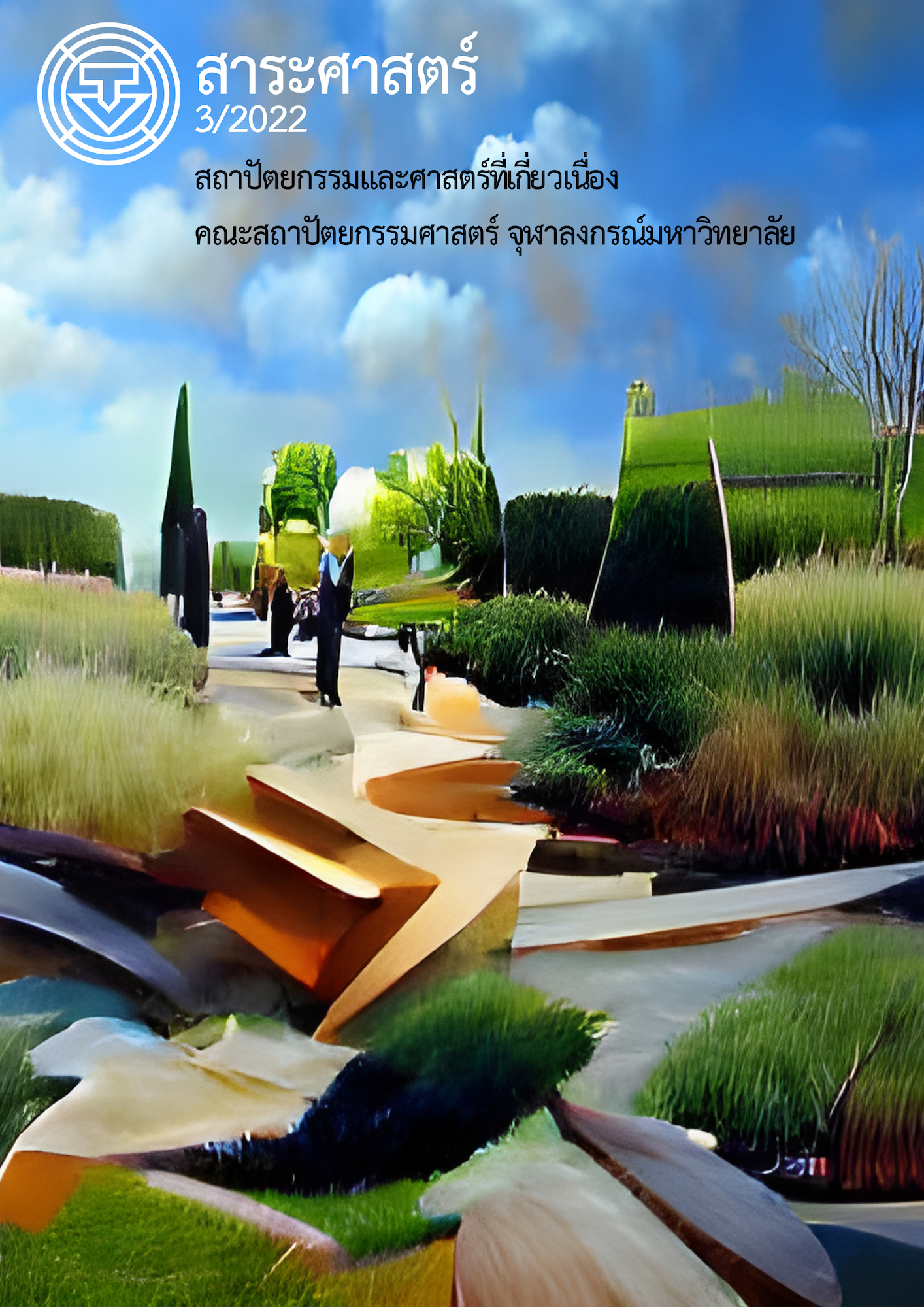ศักยภาพของชุมชนในการพัฒนาชุมชนตามแผนผังแม่บทการอนุรักษ์และพัฒนา กรุงรัตนโกสินทร์ : กรณีศึกษา ชุมชนท่าเตียน กรุงเทพมหานคร
Main Article Content
บทคัดย่อ
แผนผังแม่บทการอนุรักษ์และพัฒนากรุงรัตนโกสินทร์ มีเป้าหมายส่งเสริมการอยู่ร่วมกันของแหล่งมรดกทางวัฒนธรรมและชุมชน โดยกำหนดพื้นที่ชุมชนเป้าหมายและจัดทำแนวทางการฟื้นฟูชุมชนที่สอดคล้องกับการอนุรักษ์แหล่งมรดกทางวัฒนธรรม ซึ่งชุมชนท่าเตียนเป็นพื้นที่เป้าหมายภายในขอบเขตพื้นที่ดำเนินการบริเวณพระบรมมหาราชวัง โดยแผนผังแม่บทฯ กำหนดให้ชุมชนท่าเตียนเป็นพื้นที่ชุมชนการค้าเดิม ทำให้เกิดกิจกรรมการค้าและการบริการแก่ชุมชนและนักท่องเที่ยว การศึกษานี้ให้ความสำคัญกับศักยภาพของชุมชนท่าเตียนด้านเศรษฐกิจ สังคมและกายภาพ เนื่องจากศักยภาพชุมชนหรือผู้อยู่อาศัยมีความสำคัญอย่างมากต่อการอนุรักษ์และพัฒนาชุมชน ในการพัฒนาชุมชนตามแผนผังแม่บทฯ โดยวิธีการรวบรวมข้อมูลจากการทบทวนวรรณกรรม การสำรวจ การสัมภาษณ์และการประชุมกลุ่มย่อย ผลการศึกษาพบว่า ชุมชนท่าเตียนมีศักยภาพด้านเศรษฐกิจเป็นชุมชนการค้าสอดคล้องกับบทบาทที่กำหนดตามแผนผังแม่บทฯ ส่วนด้านสังคมเป็นครอบครัวขนาดเล็กจึงสามารถปรับเปลี่ยนหรือเปลี่ยนแปลงการใช้ประโยชน์พื้นที่อาคารจากการพักอาศัยมาทำการค้าได้มากขึ้น และมีความสัมพันธ์ลักษณะเครือญาติมากถึง 6 เครือญาติ ซึ่งสามารถเป็นตัวแทนกลุ่มเครือญาติร่วมกับผู้วิจัยในการวางแผนพัฒนาชุมชน ส่วนด้านกายภาพเป็นชุมชนในพื้นที่หัวแหวนกรุงรัตนโกสินทร์แห่งเดียว ที่มีทัศนียภาพพระปรางค์
วัดอรุณอยู่ฝั่งริมแม่น้ำเจ้าพระยาเป็นฉากหลังชุมชนและพระบรมมหาราชวังเป็นฉากหน้าชุมชน อีกทั้งยังเป็นย่านการค้าริมแม่น้ำเจ้าพระยาแห่งแรกของกรุงรัตนโกสินทร์ ดังนั้นแนวทางในการพัฒนาชุมชนที่สอดคล้องกับศักยภาพชุมชนตามแผนผังแม่บทฯ จากความเห็นพ้องร่วมกันในการประชุมกลุ่มย่อย ประกอบด้วยโครงการด้านเศรษฐกิจ 3 โครงการ ด้านสังคม 2 โครงการและด้านกายภาพ 2 โครงการ แบ่งเป็นขั้นตอนการดำเนินงานโครงการ 3 ระยะภายในเวลา 15 ปี ทำให้ทราบถึงศักยภาพและข้อจำกัดของชุมชนในแต่ละโครงการ เป็นข้อเสนอแนะกับหน่วยงานที่เกี่ยวข้องและแผนผังแม่บทฯ สามารถช่วยสนับสนุนการพัฒนาพื้นที่ชุมชนตามศักยภาพและข้อจำกัดของชุมชนได้
Article Details
เอกสารอ้างอิง
ณัฏฐนิช จำรูญโรจน์. (2563). การฟื้นฟูย่านการค้าเก่า : กรณีศึกษาย่านท่าวัง อำเภอเมือง จังหวัดนครศรีธรรมราช. (วิทยานิพนธ์ปริญญามหาบัณฑิต, มหาวิทยาลัยศิลปากร).
ปัญญา เทพสิงห์. (2556). แนวทางการฟื้นฟูชุมชน เพื่อการพัฒนาที่ยั่งยืน. วารสารวิชาการ มนุษยศาสตร์ สังคมศาสตร์, 30(2), 50-52.
มนสิชา ศรีบุญเพ็ง. (2560). กระบวนการมีส่วนร่วมในการศึกษาความต้องการของผู้อยู่อาศัยในการปรับปรุงฟื้นฟูที่อยู่อาศัยและชุมชนของสำนักงานทรัพย์สินส่วนพระมหากษัตริย์ ในย่านเมืองเก่ากรุงเทพมหานคร : กรณีศึกษา ชุมชนบริเวณสี่แยกแม้นศรี เขตป้อมปราบศัตรูพ่าย. (วิทยานิพนธ์ปริญญามหาบัณฑิต, จุฬาลงกรณ์มหาวิทยาลัย).
ลักษมี ทุ่งหว้า. (2561). การพัฒนาศักยภาพชุมชนในการจัดการทีมงาน : กรณีศึกษา กลุ่มแม่บ้านชุมชนเปรมฤทัย เขตประเวศ กรุงเทพมหานคร. วารสารเกษมบัณฑิต, 19(1), 65.
วัชรินทร์ จงกลสถิตย์. (2555). แนวคิดเกี่ยวกับชุมชน. สืบค้นเมื่อ 5 กรกฎาคม 2564, จาก https://www.slideshare.net/Watcharrin/2-14977822
สำนักงานนโยบายและแผนทรัพยากรธรรมชาติและสิ่งแวดล้อม [สผ.]. (2560). โครงการจัดทำแผนผังแม่บทการอนุรักษ์และพัฒนากรุงรัตนโกสินทร์. กรุงเทพมหานคร: ห้างหุ้นส่วนจำกัด สหายบล็อกและการพิมพ์.
อนุชา ม่วงใหญ่. (2559). แนวทางการพัฒนาเพื่อเสริมสร้างศักยภาพชุมชนและท้องถิ่น “ในศตวรรษที่ 21.” วารสารวิชาการมหาวิทยาลัยอีสเทิร์นเอเชีย ฉบับสังคมศาสตร์และมนุษยศาสตร์, 6(3), 16-17.
อุทัยทิพย์ เจี่ยวิวรรธน์กุล. (2553). การวิจัยเชิงปฏิบัติการอย่างมีส่วนร่วม : แนวคิด หลักการ และบทเรียน (พิมพ์ครั้งที่ 2).กรุงเทพมหานคร: บริษัท พี.เอ.ลีฟวิ่ง. จำกัด.
เอมอร แสนภูวา. (2559). บทบาทของผู้นำชุมชนในการมีส่วนร่วมสร้างความมั่นคงตามแนวชายแดนไทย-กัมพูชา กรณีศึกษา อำเภอกันทรลักษ์ จังหวัดศรีสะเกษ : รายงานผลการวิจัย. กรุงเทพมหานคร: สถาบันพระปกเกล้า.


